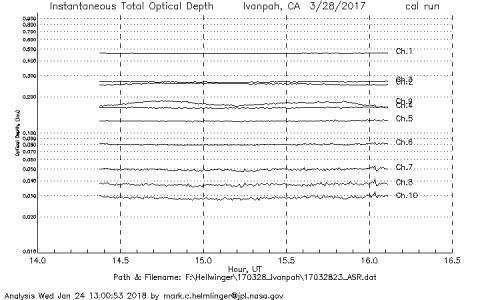 The NASA Global Hydrology Resource Center (GHRC) DAAC published the GOES-R PLT Surface Radiance Ivanpah dataset. This dataset consists of surface reflectance and total optical depth data measured at Ivanpah Playa, Nevada during the GOES-R Post Launch Test (PLT) field campaign. The atmospheric measurements were made using an Automated Solar Radiometer (ASR), which tracks the sun throughout the day. Surface reflectance measurements were made using an ASD portable spectroradiometer and Spectralon reference panel. The GOES-R PLT field campaign took place from March to May of 2017 in support of post-launch L1b and L2+ product validation of the Advanced Baseline Image (ABI) and the Geostationary Lightning Mapper (GLM). The main goal of this dataset is to provide an independent validation of the AVIRIS-NG airborne instrument calibration. Data files in Excel format and browse imagery files in JPEG and PNG formats are only available for March 23 and March 28, 2017.
The NASA Global Hydrology Resource Center (GHRC) DAAC published the GOES-R PLT Surface Radiance Ivanpah dataset. This dataset consists of surface reflectance and total optical depth data measured at Ivanpah Playa, Nevada during the GOES-R Post Launch Test (PLT) field campaign. The atmospheric measurements were made using an Automated Solar Radiometer (ASR), which tracks the sun throughout the day. Surface reflectance measurements were made using an ASD portable spectroradiometer and Spectralon reference panel. The GOES-R PLT field campaign took place from March to May of 2017 in support of post-launch L1b and L2+ product validation of the Advanced Baseline Image (ABI) and the Geostationary Lightning Mapper (GLM). The main goal of this dataset is to provide an independent validation of the AVIRIS-NG airborne instrument calibration. Data files in Excel format and browse imagery files in JPEG and PNG formats are only available for March 23 and March 28, 2017.GHRC News
 The NASA Global Hydrology Resource Center (GHRC) DAAC published the GOES-R PLT Surface Radiance Ivanpah dataset. This dataset consists of surface reflectance and total optical depth data measured at Ivanpah Playa, Nevada during the GOES-R Post Launch Test (PLT) field campaign. The atmospheric measurements were made using an Automated Solar Radiometer (ASR), which tracks the sun throughout the day. Surface reflectance measurements were made using an ASD portable spectroradiometer and Spectralon reference panel. The GOES-R PLT field campaign took place from March to May of 2017 in support of post-launch L1b and L2+ product validation of the Advanced Baseline Image (ABI) and the Geostationary Lightning Mapper (GLM). The main goal of this dataset is to provide an independent validation of the AVIRIS-NG airborne instrument calibration. Data files in Excel format and browse imagery files in JPEG and PNG formats are only available for March 23 and March 28, 2017.
The NASA Global Hydrology Resource Center (GHRC) DAAC published the GOES-R PLT Surface Radiance Ivanpah dataset. This dataset consists of surface reflectance and total optical depth data measured at Ivanpah Playa, Nevada during the GOES-R Post Launch Test (PLT) field campaign. The atmospheric measurements were made using an Automated Solar Radiometer (ASR), which tracks the sun throughout the day. Surface reflectance measurements were made using an ASD portable spectroradiometer and Spectralon reference panel. The GOES-R PLT field campaign took place from March to May of 2017 in support of post-launch L1b and L2+ product validation of the Advanced Baseline Image (ABI) and the Geostationary Lightning Mapper (GLM). The main goal of this dataset is to provide an independent validation of the AVIRIS-NG airborne instrument calibration. Data files in Excel format and browse imagery files in JPEG and PNG formats are only available for March 23 and March 28, 2017.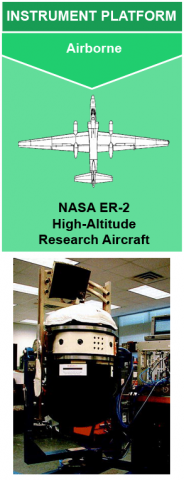 The NASA Global Hydrology Resource Center (GHRC) DAAC published the Cloud Radar System (CRS) Instrument Micro Article. The CRS is a 94 GHz, W-band, polarimetric Doppler radar that was designed to operate aboard the NASA ER-2 high-altitude research aircraft. It can also be used for ground-based operations. CRS provides high-resolution profiles of reflectivity and Doppler velocity in clouds and has important applications to atmospheric remote sensing studies. The Micro Article provides an overview of the CRS instrument and its applications to support GHRC’s current and future CRS datasets. The new Cloud Radar System Micro Article is available at https://ghrc.nsstc.nasa.gov/home/micro-articles/instrument-cloud-radar-system-crs
The NASA Global Hydrology Resource Center (GHRC) DAAC published the Cloud Radar System (CRS) Instrument Micro Article. The CRS is a 94 GHz, W-band, polarimetric Doppler radar that was designed to operate aboard the NASA ER-2 high-altitude research aircraft. It can also be used for ground-based operations. CRS provides high-resolution profiles of reflectivity and Doppler velocity in clouds and has important applications to atmospheric remote sensing studies. The Micro Article provides an overview of the CRS instrument and its applications to support GHRC’s current and future CRS datasets. The new Cloud Radar System Micro Article is available at https://ghrc.nsstc.nasa.gov/home/micro-articles/instrument-cloud-radar-system-crs
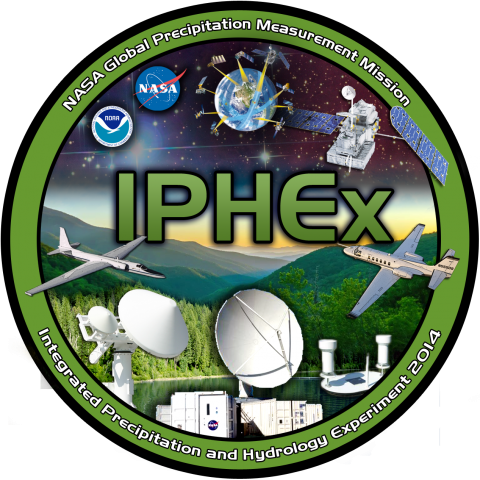 The NASA Global Hydrology Resource Center (GHRC) DAAC published the GPM Ground Validation Reference Precipitation IPHEx dataset. This dataset consists of 10 years (December 31, 2007-December 31, 2017) of hourly rainfall intensity at 1 km2 resolution over the core region of the Integrated Precipitation and Hydrology Experiment (IPHEx), that is centered in the Pigeon River Basin in North Carolina. The goal of the IPHEx field campaign was to evaluate the accuracy of satellite precipitation measurements and use the collected data for hydrology models in the region. Data files are available in ASCII format.
The NASA Global Hydrology Resource Center (GHRC) DAAC published the GPM Ground Validation Reference Precipitation IPHEx dataset. This dataset consists of 10 years (December 31, 2007-December 31, 2017) of hourly rainfall intensity at 1 km2 resolution over the core region of the Integrated Precipitation and Hydrology Experiment (IPHEx), that is centered in the Pigeon River Basin in North Carolina. The goal of the IPHEx field campaign was to evaluate the accuracy of satellite precipitation measurements and use the collected data for hydrology models in the region. Data files are available in ASCII format.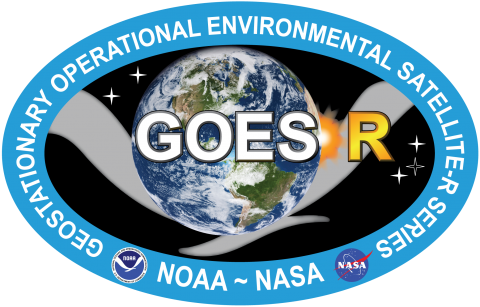 The NASA Global Hydrology Resource Center (GHRC) DAAC published the GOES-R PLT Surface Radiance Red Lake dataset. This dataset consists of surface radiation budget, ultraviolet-B (UVB) and photosynthetically active radiation (PAR) flux, meteorological (temperature, pressure, relative humidity, winds), and spectral aerosol optical thickness data collected by a mobile SURFRAD station at Red Lake, Arizona for the GOES-R Post Launch Test (PLT) field campaign. The campaign took place from March to May of 2017 in support of post-launch L1B and L2+ product validation of the Advanced Baseline Imager (ABI) and the Geostationary Lightning Mapper (GLM). Data files are available in ASCII text format from March 27, 2017 through April 12, 2017. Surface reflectance measurements based on spectroradiometer data are also included in Microsoft Excel format.
The NASA Global Hydrology Resource Center (GHRC) DAAC published the GOES-R PLT Surface Radiance Red Lake dataset. This dataset consists of surface radiation budget, ultraviolet-B (UVB) and photosynthetically active radiation (PAR) flux, meteorological (temperature, pressure, relative humidity, winds), and spectral aerosol optical thickness data collected by a mobile SURFRAD station at Red Lake, Arizona for the GOES-R Post Launch Test (PLT) field campaign. The campaign took place from March to May of 2017 in support of post-launch L1B and L2+ product validation of the Advanced Baseline Imager (ABI) and the Geostationary Lightning Mapper (GLM). Data files are available in ASCII text format from March 27, 2017 through April 12, 2017. Surface reflectance measurements based on spectroradiometer data are also included in Microsoft Excel format.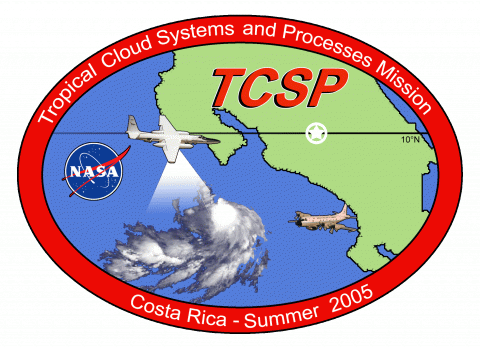 The NASA Global Hydrology Resource Center (GHRC) DAAC published the TCSP ER-2 Navigation Data. This dataset contains information recorded by the on-board navigation and data collection systems of the NASA ER-2 high-altitude research aircraft. In addition to typical navigation data (e.g., date, time, latitude/longitude, and altitude) it contains outside meteorological parameters such as wind speed, wind direction, and temperature. These data were collected during the Tropical Cloud Systems and Processes (TCSP) field campaign in July 2005, with flights based out of Juan Santamaria Airport in San Jose, Costa Rica. The main goal of the campaign was to gain further insight into the structure and lifecycle of tropical weather systems. These navigation dataset files are available from July 2 through July 27, 2005 in ASCII and PDF formats. It should be noted that there is one file per NASA ER-2 flight. Since flights did not occur each day of the campaign, data are only available on flight days.
The NASA Global Hydrology Resource Center (GHRC) DAAC published the TCSP ER-2 Navigation Data. This dataset contains information recorded by the on-board navigation and data collection systems of the NASA ER-2 high-altitude research aircraft. In addition to typical navigation data (e.g., date, time, latitude/longitude, and altitude) it contains outside meteorological parameters such as wind speed, wind direction, and temperature. These data were collected during the Tropical Cloud Systems and Processes (TCSP) field campaign in July 2005, with flights based out of Juan Santamaria Airport in San Jose, Costa Rica. The main goal of the campaign was to gain further insight into the structure and lifecycle of tropical weather systems. These navigation dataset files are available from July 2 through July 27, 2005 in ASCII and PDF formats. It should be noted that there is one file per NASA ER-2 flight. Since flights did not occur each day of the campaign, data are only available on flight days.





